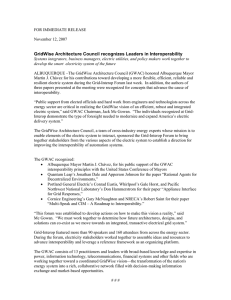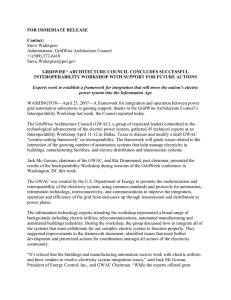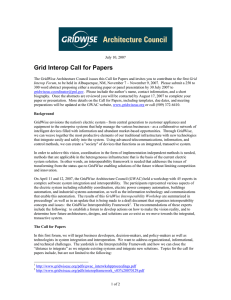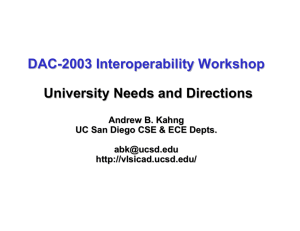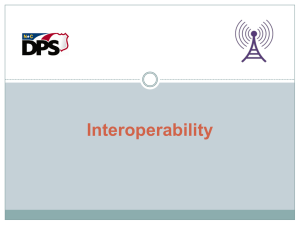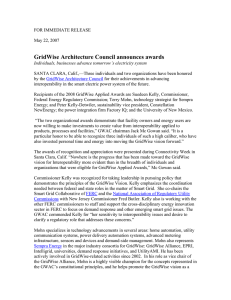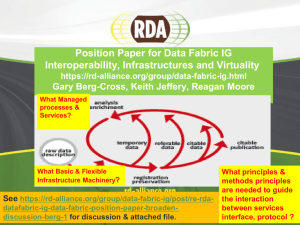Business A Possible Framework Ron Ambrosio IBM Research
advertisement
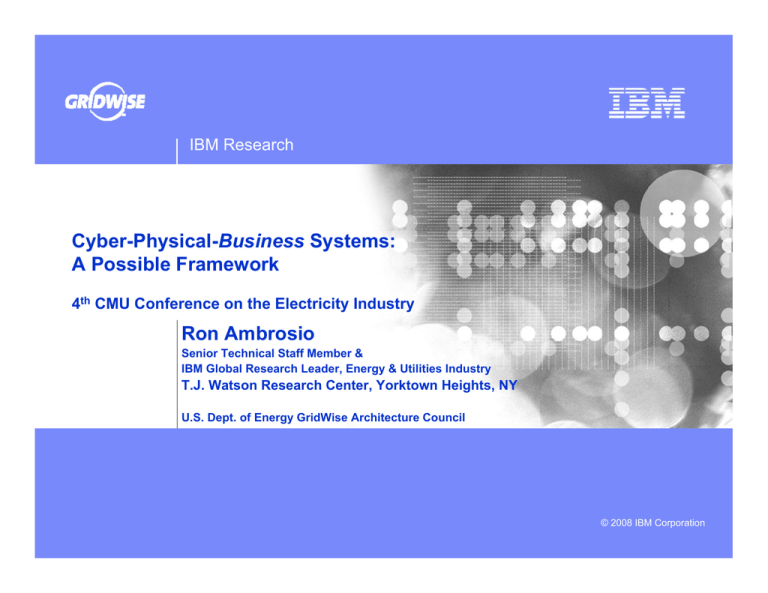
IBM Research Cyber-Physical-Business Systems: A Possible Framework 4th CMU Conference on the Electricity Industry Ron Ambrosio Senior Technical Staff Member & IBM Global Research Leader, Energy & Utilities Industry T.J. Watson Research Center, Yorktown Heights, NY U.S. Dept. of Energy GridWise Architecture Council © 2008 IBM Corporation Smart Grids as Cyber-Physical-Business Systems Intelligent Utility Networks (IUN) are about optimization … • • • • IUN’s must be viewed as extremely large-scale, distributed control systems • • Solutions must bridge the operational, business, and regulatory domains There are real technical challenges in linking the time-dependent cyber-physical operations domain with the more transactional business and regulatory domains In most solution areas, cyber-physical-business systems will need to integrate highly heterogeneous environments • 2 Because of the transient nature of the commodity the manage, they present challenges not found in many other industry segments Complex system theory, high-performance computing, and many other information technology domains will all have a significant role to play Cyber-Physical-Business Systems must be designed for interoperability in the context of business and regulatory processes • • of physical asset life-cycle management of capital investment of grid performance – asset utilization, demand mgt, reliability, … of energy resources – carbon intensity, renewables integration, … Large capital infrastructures turn over very slowly, so we must address that heterogeneity as a primary design requirement, to support evolution of the infrastructures over appropriate timeframes © 2008 IBM Corporation GridWise “Bringing the Electricity System into the Information Age” • Multiple, related government and industry activities – DoE GridWise Initiative • Under Office of Electricity Delivery and Energy Reliability (OE) – DoE GridWise Architecture Council (GWAC) • 13 member DoE advisory panel of experts from various industry segments – GridWise Alliance industry consortium (GWA) • IBM was a charter member and currently holds Chairman of the Board seat • Over 60 members as of 1Q2008 • In December 2007, the Architecture Council and the Alliance signed a Memo of Understanding to formalize the collaboration that was already taking place 3 GWAC focus is on Interoperability • Interoperable Software Expected Impact: Organization/Human – – – – – Business process Interrelations Issues Policies Communities • Technical/ (systems) – – • Information – – – – Semantics Syntax Data Business domains – Standards Interconnectivity Compliance • Reduces integration cost • Reduces cost to operate • Reduces capital IT cost • Reduces installation cost • Reduces upgrade cost • Better security management • More choice in products • More price points & features All items provide compounding benefits 4 Interoperability – Integration at Arm’s Length • Exchange of actionable information – between two or more systems – across organizational boundaries • Shared meaning of the exchanged information • Agreed expectation with consequences for the response to the information exchange • Requisite quality of service in information exchange – reliability, fidelity, security 5 An Interoperability Framework • Organizing concepts – Taxonomy, definitions, levels, tenets • Attempts to simplify the complex – Warning – it’s still complex • Aids communication between community members – Careful – semantics remain a stumbling block • • • • Provides perspective from selected viewpoints Reveals points where agreement simplifies integration Focuses on plight of integrator, not component developer EISA 2007 calls on NIST to define an Interoperability Framework – Directed to work with the GridWise Architecture Council among others 6 What do we mean by “Framework”? • • • Framework organizes concepts and provides context for discussion of detailed technical aspects of interoperability Model identifies a particular problem space and defines a technology independent analysis of requirements Design maps model requirements into a particular family of solutions – Uses standards and technical approaches • Solution manifests a design into a particular developer software technology – Ensures adherence to designs, models, and frameworks. Borrowed from NEHTA: Australian National E-Health Transition Authority 7 System Integration Philosophy • Agreement at the interface – Create an interaction contract – Terms and conditions, consequences for failure to perform… • Boundary of authority – Respect privacy of internal aspects on either side of the interface (technology choice and processes) • Decision making in very large networks – Decentralized/autonomous decision-making – Multi-agent v. hierarchical approach – Addresses scalability, evolutionary change, eases integration • Role of standards in the framework – Encourages standards for improving interoperation – Agnostic to specific standards and technologies 8 Interoperability Categories 8: Economic/Regulatory Policy Organizational (pragmatic) Informational (symantic) Technical (syntactic) Political and Economic Objectives as Embodied in Policy and Regulation 7: Business Objectives Strategic and Tactical Objectives Shared between Businesses 6: Business Procedures Alignment between Operational Business Processes and Procedures 5: Business Context Awareness of the Business Knowledge Related to a Specific Interaction 4: Semantic Understanding Understanding of the Concepts Contained in the Message Data Structures 3: Syntactic Interoperability Understanding of Data Structure in Messages Exchanged between Systems 2: Network Interoperability Mechanism to Exchange Messages between Multiple Systems across a Variety of Networks 1: Basic Connectivity Mechanism to Establish Physical and Logical Connections between Systems 9 Framework Areas of Investigation Interoperability Categories Cross-cutting Issues Æ System Evolution Æ Å System Preservation Å Discovery & Configuration Transaction & State Mgt Å Å Logging & Auditing Å 2: Network Interoperability ÅPerformance/Reliability/Scalability Æ Æ Æ Æ Æ Æ Security & Privacy Technical Å 3: Syntactic Interoperability Time Synch & Sequencing 4: Semantic Understanding Å Informational Resource Identification 5: Business Context Å 6: Business Procedures Shared Meaning of Content 7: Business Objectives Å Organizational Æ Æ 8: Economic/Regulatory Policy 1: Basic Connectivity 10 Multiple Domains of Integration Policy Domain S.95 – Not Addressed Policy Domain Regulatory Domain Enterprise Domain • Enterprise Domain S.95 Levels 4 & 5 Business Domain Operational Domain S.95 Level 3 Controller Domain S.95 Level 2 Device Domain S.95 Levels 0&1 11 Bridges the device and business worlds – understands the relationship between them (e.g., can create market bids based on HVAC state, homeowner goals, and market conditions) Controller Domain • Operational Domain Markets, customer accounts, billing, work and asset management, etc. Operational Domain • National and local legislative constructs within which cyberphysical-business systems operate Implements goals of the owner based on control settings; is influenced by the higher-levels in the system (e.g., the market prices) Device Domain • Sensor and actuator space; physical world interface – HVAC, Water Heater, Revenue Meter, etc. © 2008 IBM Corporation Internet-scale Control Systems (iCS) project at IBM Research prototype implementation of an event-based integration framework Model, at both the design and programming levels, the operational, business, and regulatory domain components of cyber-physicalbusiness system solutions as control elements • • • Apply loosely-coupled distributed computing technology and eventbased programming models to the challenge of integration across the domains: runtime middleware/services, event-based signaling, declarative programming, component/service oriented design, etc. Address the issues arising from that integration related to the critical requirements of the operational domain: time-sensitive behavior, secure-signaling, resilient communication • 12 Sensing: Information collection, data acquisition Controlling: Information/data analysis and decision making Actuating: Action/command output and execution Part of our broader Event and Stream Computing Strategy in the area of Cyber-Physical-Business Systems © 2008 IBM Corporation Guiding Architectural Principles of iCS Two communities of developers being supported: • • Maintain separation of: • • Easy to scale up – hard to scale down Enable higher-level abstraction and integration of Operational Domain systems and components through encapsulation • • 13 Solution object abstraction from solution object implementation Logical solution topology from physical device/network topology Treat time as a fundamental primitive in the programming model Must be designed for relatively small footprint systems • Object/device/service developers (“building the widgets”) Solution builders/integrators (“composing the widgets into solutions”) Accommodate heterogeneity rather than eliminate it Minimize impact on existing Operational Domain systems and skills © 2008 IBM Corporation Conclusion Interoperability is an important organizing and design theme for Cyber-Physical-Business Systems • Heterogeneity is here to stay – we must design for it to be successful • • 14 EISA 2007 directive to define and Interoperability Framework We are pulling together very diverse systems in multiple domains that weren’t designed to interoperate originally Even when standards exist, they can evolve at a different rate than the deployment of those standards, so we’ll always be faced with integration of heterogeneous components Within the Smart Grid space, the DoE GridWise Architecture Council is working with all parts of the eco-system (commercial, academic, and policy) to foster a common organizational framework for interoperability (www.gridwiseac.org, www.gridinterop.com) At IBM we are using event-based programming frameworks to extend traditional Service Oriented Architecture business systems to enable Cyber-Physical-Business Systems in many industry solutions – this has grown out of our Smart Grid (a.k.a IUN) work © 2008 IBM Corporation
